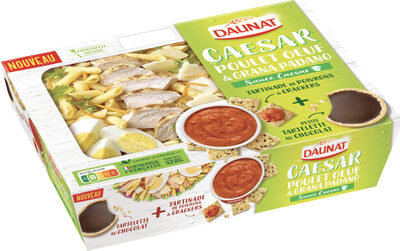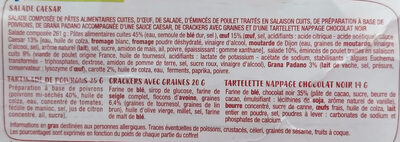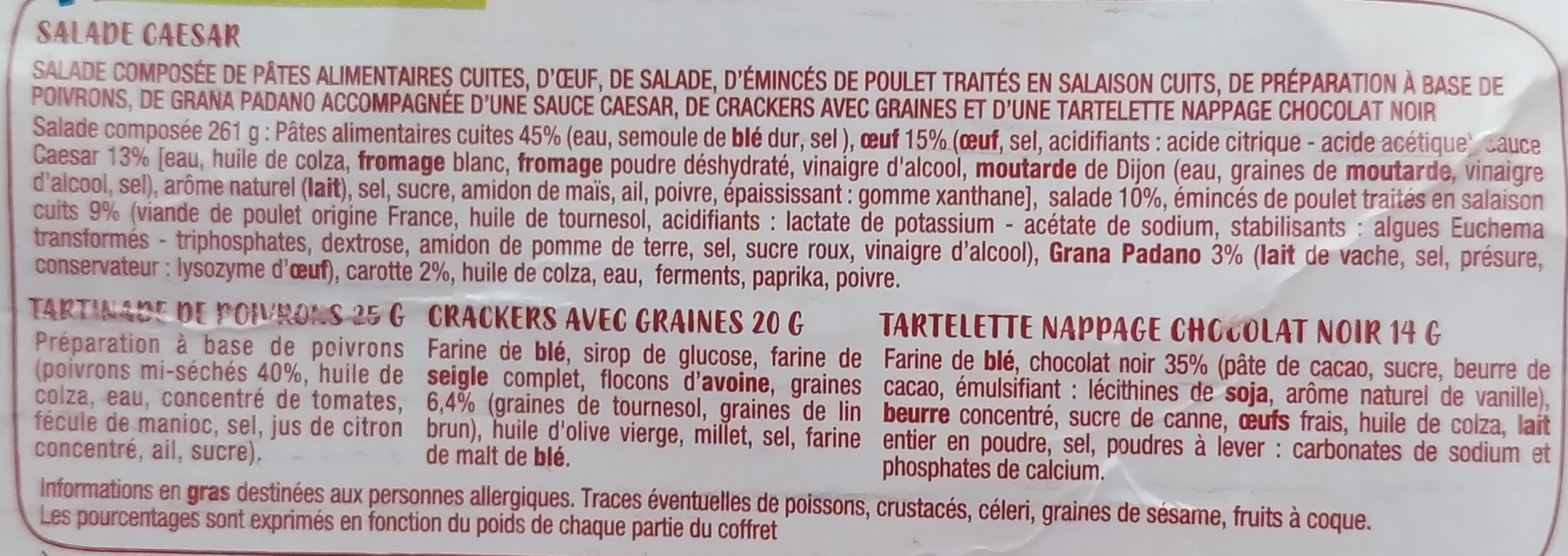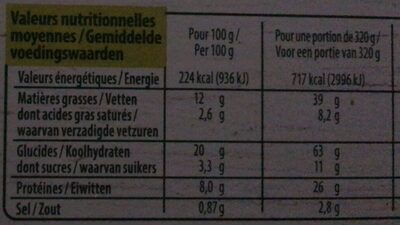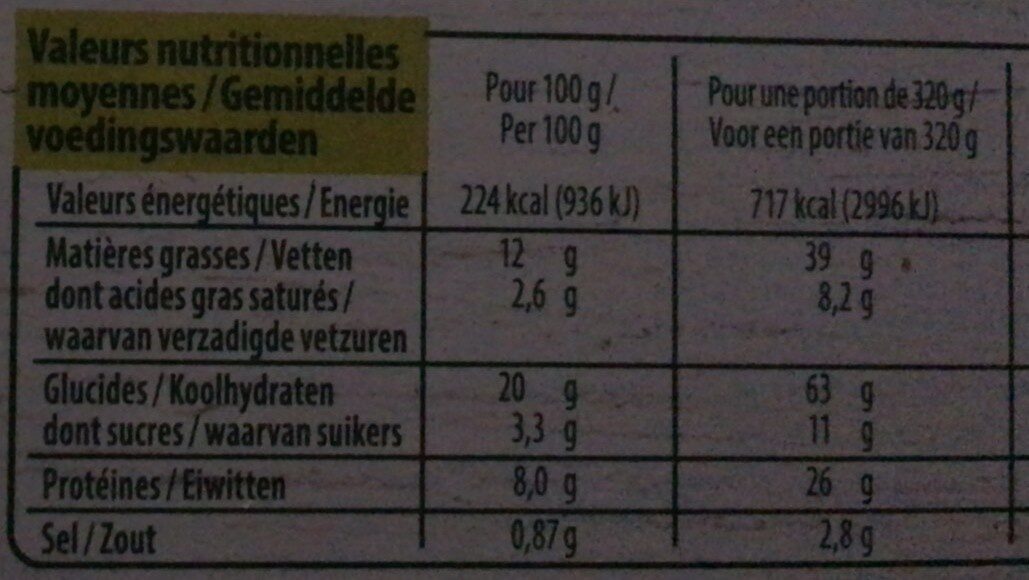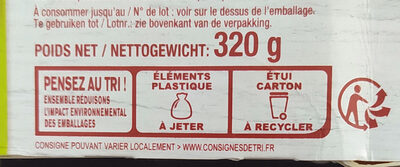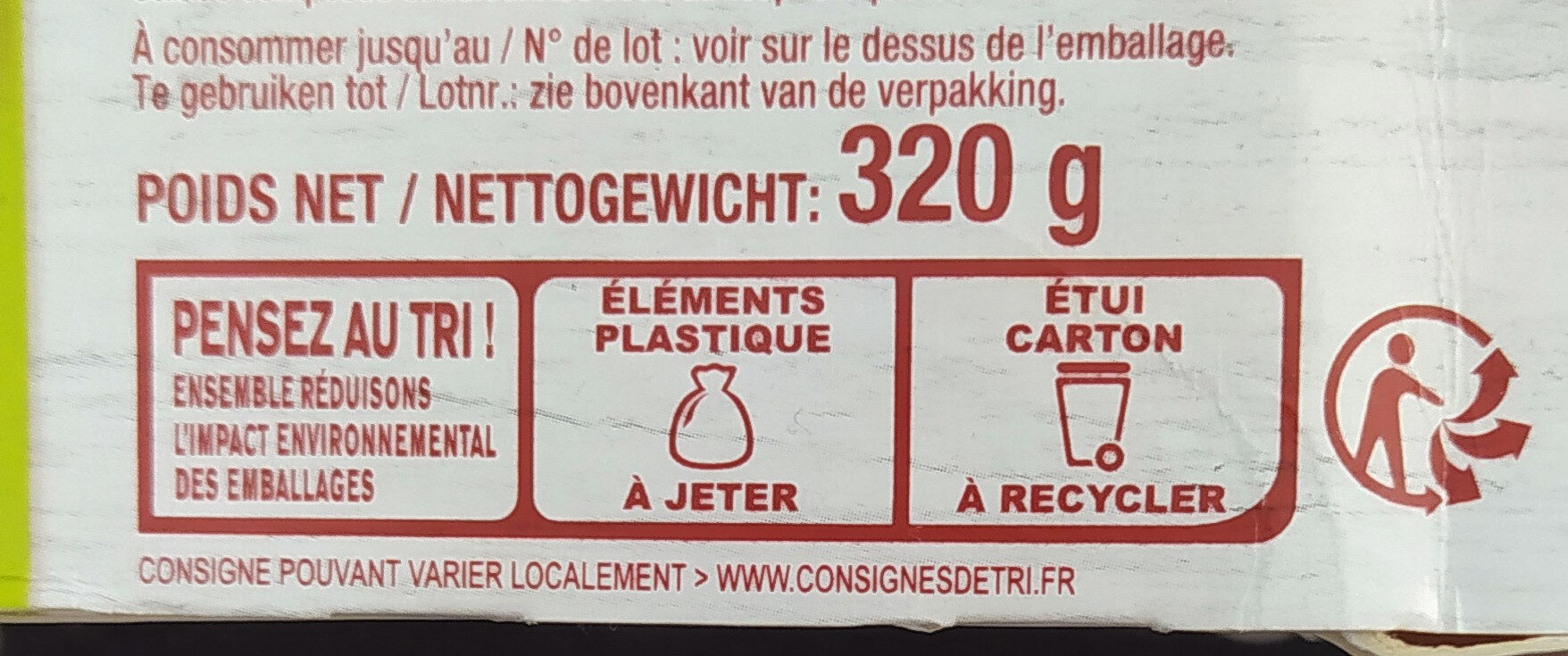Help us make food transparency the norm!
As a non-profit organization, we depend on your donations to continue informing consumers around the world about what they eat.
The food revolution starts with you!
Caesar poulet oeuf & grana padano - Daunat - 320 g
Caesar poulet oeuf & grana padano - Daunat - 320 g
Barcode: 3367651008470 (EAN / EAN-13)
Quantity: 320 g
Packaging: fr:Barquette plastique, fr:Emballage carton, fr:Etui en carton
Brands: Daunat
Categories: Meats and their products, Meals, Pasta dishes, Prepared salads, Meals with meat, Pasta salads, Poultry meals, Salads
Labels, certifications, awards:
Green Dot, Nutriscore, Nutriscore Grade B, fr:Couverts en bois 100 % biodégradable
Origin of ingredients: France
Manufacturing or processing places: Guingamp, 22200, France
Link to the product page on the official site of the producer: http://www.daunat.com
Stores: Intermarché, Auchan, carrefour.fr
Countries where sold: France
Matching with your preferences
Health
Ingredients
-
99 ingredients
: SALADE CAESAR SALADE COMPOSÉE DE PÂTES ALIMENTAIRES CUITES, D'ŒUF, DE SALADE, D'ÉMINCÉS DE POULET TRAITÉS EN SALAISON CUITS, DE PRÉPARATION À BASE DE POIVRONS, DE GRANA PADANO ACCOMPAGNÉE D'UNE SAUCE CAESAR, DE CRACKERS AVEC GRAINES ET D'UNE TARTELETTE NAPPAGE CHOCOLAT NOIR Salade composée 261 g: Pâtes alimentaires cuites 45% (eau, semoule de blé dur, sel ), œuf 15% (œuf, sel, acidifiants : acide citrique - acide acétique. Sauce Caesar 13% [eau, huile de colza, fromage blanc, fromage poudre déshydraté, vinaigre d'alcool, moutarde de Dijon (eau, graines de moutarde, vinaigre d'alcool, sel), arôme naturel (lait), sel, sucre, amidon de maïs, ail, poivre, épaississant: gomme xanthane]. Salade 10% Émincés de poulet traités en salaison cuits 9% (viande de poulet origine France, huile de tournesol, acidifiants : lactate de potassium - acétate de sodium, stabilisants : algues Euchema transformés - triphosphates, dextrose, amidon de pomme de terre, sel, sucre roux, vinaigre d'alcool). Grana Padano 3% (lait de vache, sel, présure, conservateur : lysozyme d'œuf), carotte 2%, huile de colza, eau, ferments, paprika, poivre. TARTINADE DE POIVRONS 25 G Préparation à base de poivrons (poivrons mi-séchés 40%, huile de colza, eau, concentré de tomates, fécule de manioc, sel, jus de citron concentré, ail, sucre). CRACKERS AVEC GRAINES 20G Farine de blé, sirop de glucose, farine de seigle complet, flocons d'avoine, graines 6,4% (graines de tournesol, graines de lin brun), huile d'olive vierge, millet, sel, farine de malt de blé. huile de colza, lait fécule de manioc, sel, jus de citron huile de colza, lait fécule de manioc, sel, jus de citron beurre concentré, sucre entier en poudre, sel, poudres à lever : carbonates de sodium et). TARTELETTE NAPPAGE CHOCOLAT NOIR 14 G Farine de blé, chocolat noir 35% (pâte de cacao, sucre, beurre de cacao, émulsifiant : lécithines de soja, arôme naturel de vanille), beurre concentré, sucre de canne, œufs frais, huile de colza, lait entier en poudre, sel, poudre à lever : carbonates de sodium et phosphates de calcium. Informations en gras destinées aux personnes allergiques. Traces éventuelles de poissons, crustacés, céleri, graines de sésame, fruits à coque. Les pourcentages sont exprimés en fonction du poids de chaque partie du coffretAllergens: Eggs, Milk, MustardTraces: Celery, Crustaceans, Eggs, Fish, Gluten, Milk, Mustard, Nuts, Sesame seeds, Soybeans, fr:avoine, fr:grand-padano
Food processing
-
Ultra processed foods
Elements that indicate the product is in the 4 - Ultra processed food and drink products group:
- Additive: E322 - Lecithins
- Additive: E326 - Potassium lactate
- Additive: E415 - Xanthan gum
- Additive: E451 - Triphosphates
- Ingredient: Emulsifier
- Ingredient: Flavouring
- Ingredient: Glucose
- Ingredient: Glucose syrup
- Ingredient: Thickener
Food products are classified into 4 groups according to their degree of processing:
- Unprocessed or minimally processed foods
- Processed culinary ingredients
- Processed foods
- Ultra processed foods
The determination of the group is based on the category of the product and on the ingredients it contains.
Additives
-
E260 - Acetic acid
Acetic acid: Acetic acid , systematically named ethanoic acid , is a colorless liquid organic compound with the chemical formula CH3COOH -also written as CH3CO2H or C2H4O2-. When undiluted, it is sometimes called glacial acetic acid. Vinegar is no less than 4% acetic acid by volume, making acetic acid the main component of vinegar apart from water. Acetic acid has a distinctive sour taste and pungent smell. In addition to household vinegar, it is mainly produced as a precursor to polyvinyl acetate and cellulose acetate. It is classified as a weak acid since it only partially dissociates in solution, but concentrated acetic acid is corrosive and can attack the skin. Acetic acid is the second simplest carboxylic acid -after formic acid-. It consists of a methyl group attached to a carboxyl group. It is an important chemical reagent and industrial chemical, used primarily in the production of cellulose acetate for photographic film, polyvinyl acetate for wood glue, and synthetic fibres and fabrics. In households, diluted acetic acid is often used in descaling agents. In the food industry, acetic acid is controlled by the food additive code E260 as an acidity regulator and as a condiment. In biochemistry, the acetyl group, derived from acetic acid, is fundamental to all forms of life. When bound to coenzyme A, it is central to the metabolism of carbohydrates and fats. The global demand for acetic acid is about 6.5 million metric tons per year -Mt/a-, of which approximately 1.5 Mt/a is met by recycling; the remainder is manufactured from methanol. Vinegar is mostly dilute acetic acid, often produced by fermentation and subsequent oxidation of ethanol.Source: Wikipedia
-
E262 - Sodium acetates
Sodium acetate: Sodium acetate, CH3COONa, also abbreviated NaOAc, is the sodium salt of acetic acid. This colorless deliquescent salt has a wide range of uses.Source: Wikipedia
-
E262i - Sodium acetate
Sodium acetate: Sodium acetate, CH3COONa, also abbreviated NaOAc, is the sodium salt of acetic acid. This colorless deliquescent salt has a wide range of uses.Source: Wikipedia
-
E322 - Lecithins
Lecithins are natural compounds commonly used in the food industry as emulsifiers and stabilizers.
Extracted from sources like soybeans and eggs, lecithins consist of phospholipids that enhance the mixing of oil and water, ensuring smooth textures in various products like chocolates, dressings, and baked goods.
They do not present any known health risks.
-
E322i - Lecithin
Lecithins are natural compounds commonly used in the food industry as emulsifiers and stabilizers.
Extracted from sources like soybeans and eggs, lecithins consist of phospholipids that enhance the mixing of oil and water, ensuring smooth textures in various products like chocolates, dressings, and baked goods.
They do not present any known health risks.
-
E326 - Potassium lactate
Potassium lactate: Potassium lactate is a compound with formula KC3H5O3, or H3C-CHOH-COOK. It is the potassium salt of lactic acid. It is produced by neutralizing lactic acid which is fermented from a sugar source. It has E number "E326". Potassium lactate is a liquid product that is usually 60% solids but is available at up to 78% solids.Potassium lactate is commonly used in meat and poultry products to extend shelf life and increase food safety as it has a broad antimicrobial action and is effective at inhibiting most spoilage and pathogenic bacteria. Potassium lactate is also used as an extinguishing medium in the First Alert Tundra fire extinguishers.Source: Wikipedia
-
E330 - Citric acid
Citric acid is a natural organic acid found in citrus fruits such as lemons, oranges, and limes.
It is widely used in the food industry as a flavor enhancer, acidulant, and preservative due to its tart and refreshing taste.
Citric acid is safe for consumption when used in moderation and is considered a generally recognized as safe (GRAS) food additive by regulatory agencies worldwide.
-
E341 - Calcium phosphates
Calcium phosphate: Calcium phosphate is a family of materials and minerals containing calcium ions -Ca2+- together with inorganic phosphate anions. Some so-called calcium phosphates contain oxide and hydroxide as well. They are white solids of nutritious value.Source: Wikipedia
-
E415 - Xanthan gum
Xanthan gum (E415) is a natural polysaccharide derived from fermented sugars, often used in the food industry as a thickening and stabilizing agent.
This versatile food additive enhances texture and prevents ingredient separation in a wide range of products, including salad dressings, sauces, and gluten-free baked goods.
It is considered safe for consumption even at high intake amounts.
-
E451 - Triphosphates
Sodium triphosphate: Sodium triphosphate -STP-, also sodium tripolyphosphate -STPP-, or tripolyphosphate -TPP-,- is an inorganic compound with formula Na5P3O10. It is the sodium salt of the polyphosphate penta-anion, which is the conjugate base of triphosphoric acid. It is produced on a large scale as a component of many domestic and industrial products, especially detergents. Environmental problems associated with eutrophication are attributed to its widespread use.Source: Wikipedia
-
E500 - Sodium carbonates
Sodium carbonates (E500) are compounds commonly used in food preparation as leavening agents, helping baked goods rise by releasing carbon dioxide when they interact with acids.
Often found in baking soda, they regulate the pH of food, preventing it from becoming too acidic or too alkaline. In the culinary world, sodium carbonates can also enhance the texture and structure of foods, such as noodles, by modifying the gluten network.
Generally recognized as safe, sodium carbonates are non-toxic when consumed in typical amounts found in food.
Ingredients analysis
-
May contain palm oil
Ingredients that may contain palm oil: Butterfat
-
Non-vegan
Non-vegan ingredients: Egg, Egg, Egg, Fromage blanc, Milk, Grana Padano, Cow's milk, Lysozyme from eggs, Butterfat, Fresh egg, Whole milk powderSome ingredients could not be recognized.
We need your help!
You can help us recognize more ingredients and better analyze the list of ingredients for this product and others:
- Edit this product page to correct spelling mistakes in the ingredients list, and/or to remove ingredients in other languages and sentences that are not related to the ingredients.
- Add new entries, synonyms or translations to our multilingual lists of ingredients, ingredient processing methods, and labels.
If you would like to help, join the #ingredients channel on our Slack discussion space and/or learn about ingredients analysis on our wiki. Thank you!
-
Non-vegetarian
Non-vegetarian ingredients: Lysozyme from eggsSome ingredients could not be recognized.
We need your help!
You can help us recognize more ingredients and better analyze the list of ingredients for this product and others:
- Edit this product page to correct spelling mistakes in the ingredients list, and/or to remove ingredients in other languages and sentences that are not related to the ingredients.
- Add new entries, synonyms or translations to our multilingual lists of ingredients, ingredient processing methods, and labels.
If you would like to help, join the #ingredients channel on our Slack discussion space and/or learn about ingredients analysis on our wiki. Thank you!
-
Details of the analysis of the ingredients
We need your help!
Some ingredients could not be recognized.
We need your help!
You can help us recognize more ingredients and better analyze the list of ingredients for this product and others:
- Edit this product page to correct spelling mistakes in the ingredients list, and/or to remove ingredients in other languages and sentences that are not related to the ingredients.
- Add new entries, synonyms or translations to our multilingual lists of ingredients, ingredient processing methods, and labels.
If you would like to help, join the #ingredients channel on our Slack discussion space and/or learn about ingredients analysis on our wiki. Thank you!
: SALADE CAESAR SALADE COMPOSÉE DE PÂTES ALIMENTAIRES CUITES, D'ŒUF, DE SALADE, D'ÉMINCÉS DE POULET TRAITÉS EN SALAISON CUITS, DE PRÉPARATION À BASE DE POIVRONS, DE GRANA PADANO ACCOMPAGNÉE D'UNE SAUCE CAESAR, DE CRACKERS AVEC GRAINES et D'UNE TARTELETTE NAPPAGE CHOCOLAT NOIR Salade composée (Pâtes alimentaires cuites 45%, eau), semoule de blé dur, sel, œuf 15% (œuf, sel, acidifiants (acide citrique), acide acétique, Sauce Caesar 13% (eau, huile de colza, fromage blanc, fromage poudre déshydraté, vinaigre d'alcool, moutarde de Dijon (eau, graines de moutarde, vinaigre d'alcool, sel), arôme naturel (lait), sel, sucre, amidon de maïs, ail, poivre, épaississant (gomme xanthane)), Salade 10% Émincés de poulet traités en salaison cuits 9%, Grana Padano 3% (lait de vache, sel, présure, conservateur (lysozyme d'œuf)), carotte 2%, huile de colza, eau, ferments, paprika, poivre, TARTINADE DE POIVRONS 25 G Préparation à base de poivrons (poivrons 40%, huile de colza, eau, concentré de tomates, fécule de manioc, sel, jus de citron concentré, ail, sucre), CRACKERS AVEC GRAINES 20G Farine de blé, sirop de glucose, farine de seigle complet, flocons d'avoine, graines 6.4% (graines de tournesol, graines de lin brun), huile d'olive vierge, millet, sel, farine de malt de blé, huile de colza, lait fécule de manioc, sel, jus de citron huile de colza, lait fécule de manioc, sel, jus de citron beurre concentré, sucre, sel, poudres à lever (carbonates de sodium et)), TARTELETTE NAPPAGE CHOCOLAT NOIR 14 G Farine de blé, chocolat noir 35% (pâte de cacao, sucre, beurre de cacao, émulsifiant (lécithines de soja), arôme naturel de vanille), beurre concentré, sucre de canne, œufs frais, huile de colza, lait entier en poudre, sel, poudre à lever (carbonates de sodium, phosphates de calcium)- SALADE CAESAR SALADE COMPOSÉE DE PÂTES ALIMENTAIRES CUITES -> fr:salade-caesar-salade-composee-de-pates-alimentaires-cuites
- D'ŒUF -> en:egg - vegan: no - vegetarian: yes - ciqual_food_code: 22000
- DE SALADE -> en:salad - vegan: yes - vegetarian: yes
- D'ÉMINCÉS DE POULET TRAITÉS EN SALAISON CUITS -> fr:d-eminces-de-poulet-traites-en-salaison-cuits
- DE PRÉPARATION À BASE DE POIVRONS -> fr:de-preparation-a-base-de-poivrons
- DE GRANA PADANO ACCOMPAGNÉE D'UNE SAUCE CAESAR -> fr:de-grana-padano-accompagnee-d-une-sauce-caesar
- DE CRACKERS AVEC GRAINES et D'UNE TARTELETTE NAPPAGE CHOCOLAT NOIR Salade composée -> fr:de-crackers-avec-graines-et-d-une-tartelette-nappage-chocolat-noir-salade-composee
- Pâtes alimentaires cuites -> en:cooked-pasta - vegan: maybe - vegetarian: maybe - ciqual_proxy_food_code: 9810 - percent: 45
- eau -> en:water - vegan: yes - vegetarian: yes - ciqual_food_code: 18066
- semoule de blé dur -> en:durum-wheat-semolina - vegan: yes - vegetarian: yes - ciqual_food_code: 9610
- sel -> en:salt - vegan: yes - vegetarian: yes - ciqual_food_code: 11058
- œuf -> en:egg - vegan: no - vegetarian: yes - ciqual_food_code: 22000 - percent: 15
- œuf -> en:egg - vegan: no - vegetarian: yes - ciqual_food_code: 22000
- sel -> en:salt - vegan: yes - vegetarian: yes - ciqual_food_code: 11058
- acidifiants -> en:acid
- acide citrique -> en:e330 - vegan: yes - vegetarian: yes
- acide acétique -> en:e260 - vegan: yes - vegetarian: yes
- Sauce Caesar -> fr:sauce-caesar - percent: 13
- eau -> en:water - vegan: yes - vegetarian: yes - ciqual_food_code: 18066
- huile de colza -> en:colza-oil - vegan: yes - vegetarian: yes - from_palm_oil: no - ciqual_food_code: 17130
- fromage blanc -> en:fromage-blanc - vegan: no - vegetarian: maybe - ciqual_food_code: 19501
- fromage poudre déshydraté -> fr:fromage-poudre-deshydrate
- vinaigre d'alcool -> en:alcohol-vinegar - vegan: yes - vegetarian: yes - ciqual_food_code: 11018
- moutarde de Dijon -> en:dijon-mustard - ciqual_food_code: 11013
- eau -> en:water - vegan: yes - vegetarian: yes - ciqual_food_code: 18066
- graines de moutarde -> en:mustard-seed - vegan: yes - vegetarian: yes - ciqual_food_code: 11013
- vinaigre d'alcool -> en:alcohol-vinegar - vegan: yes - vegetarian: yes - ciqual_food_code: 11018
- sel -> en:salt - vegan: yes - vegetarian: yes - ciqual_food_code: 11058
- arôme naturel -> en:natural-flavouring - vegan: maybe - vegetarian: maybe
- lait -> en:milk - vegan: no - vegetarian: yes - ciqual_proxy_food_code: 19051
- sel -> en:salt - vegan: yes - vegetarian: yes - ciqual_food_code: 11058
- sucre -> en:sugar - vegan: yes - vegetarian: yes - ciqual_proxy_food_code: 31016
- amidon de maïs -> en:corn-starch - vegan: yes - vegetarian: yes - ciqual_food_code: 9510
- ail -> en:garlic - vegan: yes - vegetarian: yes - ciqual_food_code: 11000
- poivre -> en:pepper - vegan: yes - vegetarian: yes
- épaississant -> en:thickener
- gomme xanthane -> en:e415 - vegan: yes - vegetarian: yes
- Salade 10% Émincés de poulet traités en salaison cuits -> fr:salade-10-eminces-de-poulet-traites-en-salaison-cuits - percent: 9
- Grana Padano -> en:grana-padano - vegan: no - vegetarian: maybe - ciqual_food_code: 12123 - percent: 3
- lait de vache -> en:cow-s-milk - vegan: no - vegetarian: yes - ciqual_proxy_food_code: 19051
- sel -> en:salt - vegan: yes - vegetarian: yes - ciqual_food_code: 11058
- présure -> en:rennet - vegan: maybe - vegetarian: maybe
- conservateur -> en:preservative
- lysozyme d'œuf -> en:lysozyme-from-eggs - vegan: no - vegetarian: no
- carotte -> en:carrot - vegan: yes - vegetarian: yes - ciqual_food_code: 20009 - percent: 2
- huile de colza -> en:colza-oil - vegan: yes - vegetarian: yes - from_palm_oil: no - ciqual_food_code: 17130
- eau -> en:water - vegan: yes - vegetarian: yes - ciqual_food_code: 18066
- ferments -> en:ferment - vegan: maybe - vegetarian: maybe
- paprika -> en:paprika - vegan: yes - vegetarian: yes - ciqual_food_code: 11049
- poivre -> en:pepper - vegan: yes - vegetarian: yes
- TARTINADE DE POIVRONS 25 G Préparation à base de poivrons -> fr:tartinade-de-poivrons-25-g-preparation-a-base-de-poivrons
- poivrons -> en:bell-pepper - vegan: yes - vegetarian: yes - ciqual_food_code: 20041 - percent: 40
- huile de colza -> en:colza-oil - vegan: yes - vegetarian: yes - from_palm_oil: no - ciqual_food_code: 17130
- eau -> en:water - vegan: yes - vegetarian: yes - ciqual_food_code: 18066
- concentré de tomates -> en:tomato-concentrate - vegan: yes - vegetarian: yes - ciqual_food_code: 20068
- fécule de manioc -> en:tapioca - vegan: yes - vegetarian: yes - ciqual_proxy_food_code: 9510
- sel -> en:salt - vegan: yes - vegetarian: yes - ciqual_food_code: 11058
- jus de citron concentré -> en:concentrated-lemon-juice - vegan: yes - vegetarian: yes - ciqual_food_code: 2028
- ail -> en:garlic - vegan: yes - vegetarian: yes - ciqual_food_code: 11000
- sucre -> en:sugar - vegan: yes - vegetarian: yes - ciqual_proxy_food_code: 31016
- CRACKERS AVEC GRAINES 20G Farine de blé -> fr:crackers-avec-graines-20g-farine-de-ble
- sirop de glucose -> en:glucose-syrup - vegan: yes - vegetarian: yes - ciqual_proxy_food_code: 31016
- farine de seigle complet -> en:wholemeal-rye-flour - vegan: yes - vegetarian: yes - ciqual_proxy_food_code: 9530
- flocons d'avoine -> en:oat-flakes - vegan: yes - vegetarian: yes - ciqual_food_code: 9311
- graines -> en:seed - vegan: yes - vegetarian: yes - percent: 6.4
- graines de tournesol -> en:sunflower-seed - vegan: yes - vegetarian: yes - ciqual_food_code: 15011
- graines de lin brun -> en:brown-flax-seeds - vegan: yes - vegetarian: yes - ciqual_food_code: 15052
- huile d'olive vierge -> en:virgin-olive-oil - vegan: yes - vegetarian: yes - from_palm_oil: no - ciqual_proxy_food_code: 17270
- millet -> en:millet - vegan: yes - vegetarian: yes - ciqual_food_code: 9330
- sel -> en:salt - vegan: yes - vegetarian: yes - ciqual_food_code: 11058
- farine de malt de blé -> en:malted-wheat-flour - vegan: yes - vegetarian: yes - ciqual_proxy_food_code: 9410
- huile de colza -> en:colza-oil - vegan: yes - vegetarian: yes - from_palm_oil: no - ciqual_food_code: 17130
- lait fécule de manioc -> fr:lait-fecule-de-manioc
- sel -> en:salt - vegan: yes - vegetarian: yes - ciqual_food_code: 11058
- jus de citron huile de colza -> fr:jus-de-citron-huile-de-colza
- lait fécule de manioc -> fr:lait-fecule-de-manioc
- sel -> en:salt - vegan: yes - vegetarian: yes - ciqual_food_code: 11058
- jus de citron beurre concentré -> fr:jus-de-citron-beurre-concentre
- sucre -> en:sugar - vegan: yes - vegetarian: yes - ciqual_proxy_food_code: 31016
- sel -> en:salt - vegan: yes - vegetarian: yes - ciqual_food_code: 11058
- poudres à lever -> en:raising-agent
- carbonates de sodium et -> en:e500i - vegan: yes - vegetarian: yes
- TARTELETTE NAPPAGE CHOCOLAT NOIR 14 G Farine de blé -> fr:tartelette-nappage-chocolat-noir-14-g-farine-de-ble
- chocolat noir -> en:dark-chocolate - vegan: maybe - vegetarian: yes - ciqual_proxy_food_code: 31074 - percent: 35
- pâte de cacao -> en:cocoa-paste - vegan: yes - vegetarian: yes - ciqual_proxy_food_code: 16030
- sucre -> en:sugar - vegan: yes - vegetarian: yes - ciqual_proxy_food_code: 31016
- beurre de cacao -> en:cocoa-butter - vegan: yes - vegetarian: yes - ciqual_food_code: 16030
- émulsifiant -> en:emulsifier
- lécithines de soja -> en:soya-lecithin - vegan: yes - vegetarian: yes - ciqual_food_code: 42200
- arôme naturel de vanille -> en:natural-vanilla-flavouring - vegan: yes - vegetarian: yes
- beurre concentré -> en:butterfat - vegan: no - vegetarian: yes - from_palm_oil: maybe - ciqual_food_code: 16401
- sucre de canne -> en:cane-sugar - vegan: yes - vegetarian: yes - ciqual_proxy_food_code: 31016
- œufs frais -> en:fresh-egg - vegan: no - vegetarian: yes - ciqual_food_code: 22000
- huile de colza -> en:colza-oil - vegan: yes - vegetarian: yes - from_palm_oil: no - ciqual_food_code: 17130
- lait entier en poudre -> en:whole-milk-powder - vegan: no - vegetarian: yes - ciqual_food_code: 19021
- sel -> en:salt - vegan: yes - vegetarian: yes - ciqual_food_code: 11058
- poudre à lever -> en:raising-agent
- carbonates de sodium -> en:e500 - vegan: yes - vegetarian: yes
- phosphates de calcium -> en:e341 - vegan: yes - vegetarian: yes
Nutrition
-
Good nutritional quality
⚠ ️Warning: the amount of fruits, vegetables and nuts is not specified on the label, it was estimated from the list of ingredients: 54This product is not considered a beverage for the calculation of the Nutri-Score.
Positive points: 5
- Proteins: 4 / 5 (value: 8, rounded value: 8)
- Fiber: 0 / 5 (value: 0, rounded value: 0)
- Fruits, vegetables, nuts, and colza/walnut/olive oils: 1 / 5 (value: 54.503057718277, rounded value: 54.5)
Negative points: 7
- Energy: 2 / 10 (value: 937, rounded value: 937)
- Sugars: 0 / 10 (value: 3.3, rounded value: 3.3)
- Saturated fat: 2 / 10 (value: 2.6, rounded value: 2.6)
- Sodium: 3 / 10 (value: 348, rounded value: 348)
The points for proteins are counted because the negative points are less than 11.
Nutritional score: (7 - 5)
Nutri-Score:
-
Nutrient levels
-
Fat in moderate quantity (12%)
What you need to know- A high consumption of fat, especially saturated fats, can raise cholesterol, which increases the risk of heart diseases.
Recommendation: Limit the consumption of fat and saturated fat- Choose products with lower fat and saturated fat content.
-
Saturated fat in moderate quantity (2.6%)
What you need to know- A high consumption of fat, especially saturated fats, can raise cholesterol, which increases the risk of heart diseases.
Recommendation: Limit the consumption of fat and saturated fat- Choose products with lower fat and saturated fat content.
-
Sugars in low quantity (3.3%)
What you need to know- A high consumption of sugar can cause weight gain and tooth decay. It also augments the risk of type 2 diabetes and cardio-vascular diseases.
Recommendation: Limit the consumption of sugar and sugary drinks- Sugary drinks (such as sodas, fruit beverages, and fruit juices and nectars) should be limited as much as possible (no more than 1 glass a day).
- Choose products with lower sugar content and reduce the consumption of products with added sugars.
-
Salt in moderate quantity (0.87%)
What you need to know- A high consumption of salt (or sodium) can cause raised blood pressure, which can increase the risk of heart disease and stroke.
- Many people who have high blood pressure do not know it, as there are often no symptoms.
- Most people consume too much salt (on average 9 to 12 grams per day), around twice the recommended maximum level of intake.
Recommendation: Limit the consumption of salt and salted food- Reduce the quantity of salt used when cooking, and don't salt again at the table.
- Limit the consumption of salty snacks and choose products with lower salt content.
-
-
Nutrition facts
Nutrition facts As sold
for 100 g / 100 mlAs sold
per serving (320g)Compared to: Pasta salads Energy 937 kj
(224 kcal)3,000 kj
(717 kcal)+28% Fat 12 g 38.4 g +37% Saturated fat 2.6 g 8.32 g +71% Carbohydrates 20 g 64 g +27% Sugars 3.3 g 10.6 g +36% Fiber - - Proteins 8 g 25.6 g +28% Salt 0.87 g 2.78 g +4% Fruits‚ vegetables‚ nuts and rapeseed‚ walnut and olive oils (estimate from ingredients list analysis) 54.503 % 54.503 %
Environment
-
Eco-Score D - High environmental impact
⚠ ️Select a country in order to include the full impact of transportation.The Eco-Score is an experimental score that summarizes the environmental impacts of food products.→ The Eco-Score was initially developped for France and it is being extended to other European countries. The Eco-Score formula is subject to change as it is regularly improved to make it more precise and better suited to each country.Life cycle analysis
-
Average impact of products of the same category: C (Score: 42/100)
Category: Chicken, Basque style
Category: Chicken, Basque style
- PEF environmental score: 0.69 (the lower the score, the lower the impact)
- including impact on climate change: 5.17 kg CO2 eq/kg of product
Stage Impact Agriculture
77.8 %Processing
14.2 %Packaging
2.3 %Transportation
3.4 %Distribution
1.3 %Consumption
0.9 %
Bonuses and maluses
-
Origins of ingredients with a medium impact
Bonus: +4
Environmental policy: +4
Transportation: 0
Origin of the product and/or its ingredients % of ingredients Impact France 100 %Medium Unknown 0 %High
-
Packaging with a medium impact
Malus: -12
Shape Material Recycling Impact Tray Plastic High Packaging Cardboard Low Sleeve Cardboard Low
Eco-Score for this product
-
Impact for this product: D (Score: 34/100)
Product: Caesar poulet oeuf & grana padano - Daunat - 320 g
Life cycle analysis score: 42
Sum of bonuses and maluses: -8
Final score: 34/100
-
Carbon footprint
-
Equal to driving 2.7 km in a petrol car
517 g CO² per 100g of product
The carbon emission figure comes from ADEME's Agribalyse database, for the category: Chicken, Basque style (Source: ADEME Agribalyse Database)
Stage Impact Agriculture
72.0 %Processing
17.7 %Packaging
3.6 %Transportation
5.7 %Distribution
0.7 %Consumption
0.3 %
Packaging
-
Packaging with a medium impact
-
Packaging parts
Tray (Plastic)
Packaging (Cardboard)
Sleeve (Cardboard)
-
Packaging materials
Material % Packaging weight Packaging weight per 100 g of product Paper or cardboard Plastic Total
-
Transportation
-
Origins of ingredients
Origins of ingredients with a medium impact
Origin of the product and/or its ingredients % of ingredients Impact France 100 %Medium Unknown 0 %High
Report a problem
-
Incomplete or incorrect information?
Category, labels, ingredients, allergens, nutritional information, photos etc.
If the information does not match the information on the packaging, please complete or correct it. Open Food Facts is a collaborative database, and every contribution is useful for all.
Data sources
Product added on by kiliweb
Last edit of product page on by foodvisor.
Product page also edited by charlesnepote, driveoff, ecoscore-impact-estimator, moon-rabbit, packbot, roboto-app, sasa, yuka.NplvB9e2ItIdLMb03KwT3ha4Cf_uCP1_AGUvow, yuka.sY2b0xO6T85zoF3NwEKvlkx1eMH5s2qVJgzVn1yL_vuiPID4Z-hv_JnAOqs, yuka.sY2b0xO6T85zoF3NwEKvlnZOYfiAqDL5bDrSknHTmvzSJLm1Ps0j6ZfZLqs.
